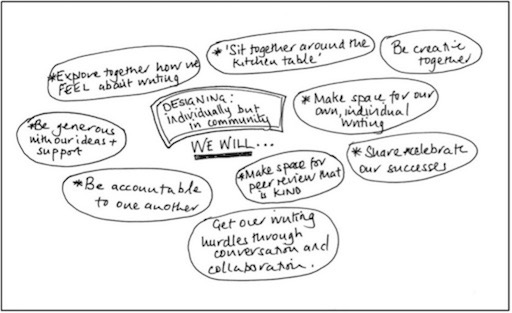3 Finding the design elements
At this point in your inquiry, you will begin to identify what needs to happen to transform the imagined future that you have captured in your provocative proposition into a reality. Perhaps what follows will appear more familiar to you than some of what has gone before – there will be some concrete outcomes as a result of the activities in this section that will have emerged from an appreciative climate. However, this phase should retain some of the creative flair that has characterised the earlier phases of the inquiry. Cooperrider and Whitney (2005) suggest framing the activities in this phase with the question: What would [the inquiry focus] look like if it were designed in every way possible to maximise the possibilities of the positive core and enable the accelerated realisation of our dreams?
Moving towards some concrete outcomes requires identifying the core elements of the provocative proposition that need to be designed if the imagined future is to be reached. One way to maintain both creativity and momentum at this point in the process, either individually or collectively, is to generate a thought cloud with as many ideas as possible for each of the design elements you have identified. Cooperrider, Whitney and Stavros (2008, p. 172) suggest some helpful rules for this kind of brainstorm:
- defer judgement – don’t dismiss any ideas
- encourage wild ideas – be radical
- build on the ideas of others; don’t use buts; use only ands
- stay focused on the topic
- hold one conversation at a time
- be visual
- go for quantity.
These ‘rules’ maintain the sense of generativity and improvisation that are at the core of appreciative inquiry, while creating a climate in which some concrete actions and strategies can emerge.
Activity 4 Provocative themes
Look again at the provocative proposition that emerged in relation to the writing community that was introduced in Activity 3. Can you highlight three phrases that might form the core elements of the design of this community?
The writing space will be one in which participants can write individually but in community with others. It will be a space where creativity and dialogue are actively encouraged in ways that nourish and encourage the writing of one another.
Comment
The writing space will be one in which participants can write individually but in community with others. It will be a space where creativity and dialogue are actively encouraged in ways that nourish and encourage the writing of one another.
The words that you highlighted in the previous activity are the three core elements the group identified and below is an example of the kind of thought cloud that might emerge from just one of these: writing individually but in community. It captures some concrete commitments that will characterise the writing community and will underpin the community’s overall design.
The group used the thought cloud to consider what activities might best capture these commitments so that the community reflected the characteristics of the imagined future. Their ideas included:
- identifying a space where everyone can be together, but break out into other spaces to write individually
- beginning each session with a creative writing task
- sharing individual writing targets at the start of the session and reporting on progress at the end
- providing opportunities for individuals to share extracts of their writing and to request feedback on a specific aspect
- providing opportunities for colleagues to put a writing challenge ‘on the table’ and collaboratively exploring positive ways forward.
These initial ideas both capture the heart of the provocative proposition and begin to shape the ways in which the writing community might operate in practice. Each one constitutes a design statement and can form a basis for action in the next phase of the inquiry.
Activity 5 Writing design statements
This activity will help you to develop your own design statements from the proposition that you wrote in Activity 3, so make sure you have that statement to hand.
- a.Highlight up to three core elements that should be addressed in the design phase (as was modelled in Activity 4)
- b.Create a thought cloud similar to the example in Figure 4 to identify concrete actions that might be taken to move towards your imagined future.
The next section will help us move from thinking about finding the design elements from our stories to thinking about how we can act upon these by creating the conditions we need for our inquiry.

